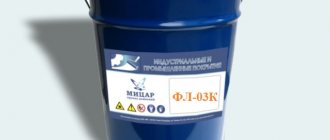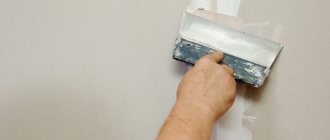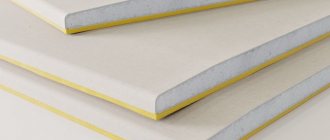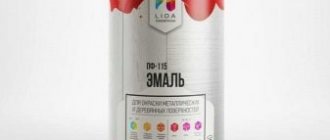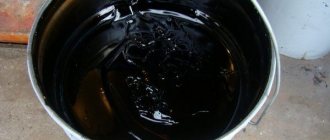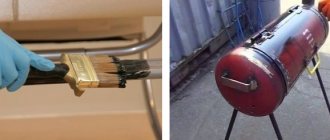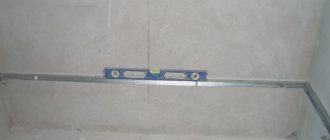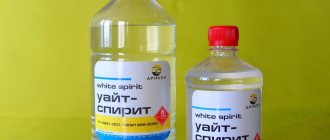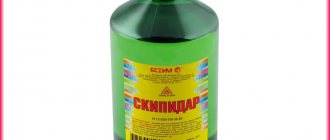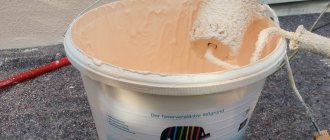State Standard for oil paint defines it as a suspension of pigment or its mixture with fillers in a film-forming substance from various brands of drying oils. The material, after it dries, creates an opaque film on the base, which has decorative and protective properties.
Labeling of compositions allows consumers to navigate their diversity and find the best option for themselves. It reflects the composition of paintwork materials, the type of surfaces that can be painted with it and some properties of the paint.
High-quality paints must be manufactured in accordance with State Standards and have a certificate confirming this.
The instructions on the packaging allow you to find out the main technical characteristics of the coating. This information is very useful, because it helps you choose the right paint for your purposes.
Description and purpose of paint
The paint and varnish material oil paint MA-15 is manufactured according to the state standard GOST 1503-71, Infrakhim, LKZ Kolorit and many others. This product contains combined drying oils (brands – K2, K3, K5) or drying oil of natural origin “Oxol”. Various fillers, pigments, and special-purpose siccatives are used as additives.
The paint is available in different colors:
The color of the product depends on the type of pigment included. The composition may contain titanium white, ocher, zinc white, mummy, chromium oxide, red lead and others. It is possible to produce any shade of material at the request of the client.
The use of the product is wide. It is used to cover wooden products, apply it to metal, concrete surfaces, paint floors and walls. It is used for exterior and interior decoration and is popular in construction and renovation. Material properties:
- resistance to temperature changes;
- rust protection;
- giving a beautiful appearance to products;
- formation of a durable coating in areas subject to severe wear;
- light fastness, plasticity;
- excellent adhesion to any surfaces;
- antibacterial qualities, the ability to resist microbes and mold;
- ease of application, ease of use.
When the coating is completely dry, it is 100% safe and can even be used in children's rooms.
General information about the material
Painting the walls of the house
Oil paints are widely in demand for both exterior and interior work. Due to its characteristics, it is used for wooden floors, walls in bathrooms and other rooms. Reliability and quality are two main properties of paints and varnishes. It is better to carry out work for such mixtures in the warm and dry season, this is especially important for PF 115 enamel. If you see the inscription GOST 10503-71 on the paint package, then you should not worry about the quality of this material. GOST 10503-71 is confirmation of production in accordance with strictly prescribed regulations.
Before updating the decorative oil coating, you should remove the old finish from the walls and only then reapply the oil mixture using a brush or other tools.
Material characteristics
The technical characteristics of this material are in the description of its properties specified in the certificate of conformity and the batch passport. Main parameters:
- surface – flat, smooth, without pockmarks or craters, without defects;
- the share of dry residue in the composition is 12%, the share of film-forming substances is 26%;
- degree of grinding – 90 microns;
- viscosity according to the VZ-246 viscometer at a temperature of +20 degrees – 64–140 (depending on color);
- film coverage – 45–210 g/sq.m. m (depending on color);
- Drying time for one layer is 24 hours at a temperature of +20 degrees;
- film hardness according to TML – 0.05 cu;
- lightfastness of the coating – 2 hours;
- resistance to water at room temperature – 0.5 hours.
TECHNICAL REQUIREMENTS
1.1. Depending on the purpose, oil-based thickened paints are produced in the brands and colors indicated in Table 1, with the corresponding OKP codes.
Table 1
| OKP code for the brand | |||||
| Name of paint, color | MA-015 | MA-015 red lead iron | MA-015 mummy | MA-015 ocher | MA-025 for indoor use |
| for use in atmospheric conditions | |||||
| Thickly grated colored oil paints: | 23 1712 2700 05 | 12 1712 2800 02 | 23 1712 3000 00 | 23 1712 3100 08 | 23 1712 2100 01 |
| red | 23 17122106 06 | ||||
| dark red | 23 1712 2164 07 | ||||
| creamy | 23 1712 2714 10 | 23 1712 2114 06 | |||
| dark yellow | 23 1712 2762 02 | 23 1712 2162 09 | |||
| 209 | 23 1712 2108 04 | ||||
| green | 23 1712 2708 08 | 23 1712 2143 01 | |||
| pistachio | 23 1712 2743 05 | 23 1712 2129 10 | |||
| yellow-green | 23 1712 2171 08 | ||||
| blue 424 | 23 1712 2771 01 | 23 1712 2110 10 | |||
| blue 475 | 23 1712 2710 03 | 23 1712 2107 05 | |||
| blue | 23 1712 2160 00 | ||||
| dark gray | 23 1712 2760 04 | 23 1712 2196 10 | |||
| light beige | 23 1712 2796 03 | 23 1712 2117 03 | |||
| beige | 23 1712 2717 07 | 23 1712 2109 03 | |||
| brown | 23 1712 2709 07 | ||||
| red-brown | 23 1712 2858 06 | ||||
| brownish red | 23 1712 3058 04 | ||||
| from yellow to light brown | 23 1712 3184 10 | ||||
1.2. Thickly ground oil paints must be manufactured in accordance with the requirements of this standard according to the recipe and technological regulations approved in the prescribed manner.
1.3. Before use, thickly ground oil paints are diluted with drying oils in an amount of 20-30% (for brands MA-015 and MA-025) and 30-40% (for brands MA-015 red lead, MA-015 mummy, MA-015 ocher) by weight thick rubbed paint.
Paints of brands MA-015, MA-015 red lead, MA-015 mummy, MA-015 ocher are diluted with natural drying oils (GOST 7931-76) or combined K-3, K-5.
Paints of the MA-025 brand are diluted with natural drying oils, “Oxol” (GOST 190-78) or combined K-2, K-3, K-5.
Before use, it is allowed to dilute paints of the brands MA-015, MA-015 red lead, MA-015 mummy, MA-015 ocher with Oxol drying oil, and the paints are used only for indoor coatings.
1.4. After dilution with drying oil, paints are, if necessary, diluted with white spirit (nefras -155/200) (GOST 3134-78) in an amount of no more than 5% by weight of the paint.
1.3, 1.4. (Changed edition, Revised, No. 1).
1.5. When using ocher, up to 2% of NF-1 grade (GOST 1003-73) or ZhK-1 grade drier is added by weight of the paint.
1.6. The method of using oil-based colored thick-set paints intended for retail trade is indicated in reference Appendix 1, the density - in reference Appendix 2.
(Changed edition, Amendment No. 1).
1.7. In terms of physical and chemical parameters, paints must comply with the requirements and standards specified in Table 2.
table 2
| Standard for brands | ||||||
| Indicator name | MA-015 | MA-015 red lead iron | MA-015 mummy | MA-015 ocher | MA-025 | Test method |
| 1. Paint film color: | Must be within the permissible deviations established by the “Card Index” color samples (standards) or control color samples | Must be within the permissible deviations established by color control samples | Must be within the permissible deviations established by the “Card Index” color samples (standards) or control color samples | According to clause 4.3 | ||
| red | — | — | — | — | 42, 44 | |
| Dark red | — | — | — | — | 5, color reference sample | |
| cream | 200, 201 | — | — | — | ||
| dark yellow 209 | 209, color control sample | 200, 201 | ||||
| — | — | — | 209, color control sample | |||
| green | 304, color control sample | — | — | — | 304, color control sample | |
| 309, control | ||||||
| pistachio | color swatch | — | — | — | 309, color control sample | |
| yellow-green | — | |||||
| blue 424 | 424,423 | 350, 331 | ||||
| blue 475 | 475, color control sample | 424, 474 | ||||
| 475, 434 | ||||||
| blue | — | 476, 427 | ||||
| dark grey | 526, 509 | 526, 509 | ||||
| light beige | 621, color control sample | 621, color control sample | ||||
| beige | 689, 690 | 689, 690 | ||||
| brown | 619, 623 | 619, 623 | ||||
| red-brown | — | Based on control color samples | — | |||
| brownish red | — | Same | — | |||
| yellow to light brown | — | » | — | |||
| 2. Mass fraction of film-forming substance, %, not less: | According to GOST 17537-72 and clause 4.4 of this standard | |||||
| green | 14,0 | — | — | — | 12,0 | |
| blue | — | — | — | — | 11,0 | |
| beige | 12,5 | — | — | — | 12,0 | |
| brown | 14,0 | — | — | 11,0 | ||
| other colors | 12,5 | 12,4 | 13,0 | 24,0 | 10,0 | |
| 3. Mass fraction of volatile substances, %, no more than: | According to GOST 17537-72 and clause 4.5 of this standard | |||||
| green, brown | 9,0 | — | — | — | 7,0 | |
| blue | — | — | — | — | 7,0 | |
| beige | 7,0 | — | — | — | 7,0 | |
| other colors | 7,0 | 6,5 | 7,0 | 11,5 | 6,0 | |
| 4. Covering capacity of undried paint film, g/m, not more than: | According to GOST 8784-75, section 1 | |||||
| red | — | — | — | — | 100 | |
| dark red | — | — | — | — | 100 | |
| creamy | 225 | — | — | — | 200 | |
| dark yellow 209 | 140 | — | — | — | 140 | |
| green | 70 | — | — | — | 100 | |
| pistachio | 90 | — | — | — | 135 | |
| yellow-green | — | — | — | — | 140 | |
| blue 424 | 100 | — | — | — | 100 | |
| blue 475 | 95 | — | — | — | 100 | |
| blue | — | — | — | — | 100 | |
| dark gray | 65 | — | — | — | 100 | |
| light beige | 160 | — | — | — | 160 | |
| beige | 85 | — | — | — | 120 | |
| brown | 65 | — | — | — | 65 | |
| other colors | — | 35 | 65 | 180 | — | |
| 5. Degree of grinding, microns, no more | 50 | 45 | 45 | 40 | 50 | According to GOST 6589-74 |
| 6. Drying time at temperature (20±2) °C to degree 3, hours, no more | 24 | 24 | 24 | 24 | 24 | According to GOST 19007-73 |
| 7. Film hardness, according to a pendulum device, conventional units, not less than: | According to GOST 5233-89 | |||||
| type M-3 | 0,13 | 0,12 | 0,12 | 0,11 | 0,10 | |
| type TML (pendulum B) | 0,05 | 0,05 | 0,05 | 0,05 | 0,05 | |
| 8. Conditional light fastness of the film, h, not less | 2 | — | — | — | — | According to GOST 21903-76 and clause 4.7 of this standard |
| 9. Resistance of the film to the static effects of water at a temperature of (20±2) °C, h, not less | 2 | — | — | — | — | According to GOST 9.403-80, section 2, and clause 4.8 of this standard |
1.8. The correspondence of the changed designations of paint colors with the previously accepted ones is given in reference Appendix 3.
Notes:
1. The norm for indicator 7 for a pendulum device of type TML (pendulum B) is not rejected until 01/01/95. Definition is required.
2. The norm for indicator 7 for a pendulum device of type M-3 is valid until 01/01/95.
(Changed edition, Amendment No. 1).
Features of application
Painting with MA-15 is carried out after preliminary surface preparation. It is cleaned from dirt, grease, stains, dust, remnants of old coating, scale and rust. Potholes and uneven areas must be filled with plaster. To enhance the adhesion strength, it is recommended to apply a primer (alkyd, glyphthalic). New wood should be pre-coated with drying oil or wood primer.
Only dry surfaces can be painted. The paint is mixed before application. If the viscosity is too high, add a solvent - turpentine, a special thinner for oil paints. Application methods: roller, brush, direct pneumatic spray. Air humidity during work is up to 80%, temperature from +5 to +35 degrees. After completion of work, the tools are washed with white spirit.
Consumption per layer
The consumption of 1 m2 of product significantly depends on the absorbency of the surface, the method of application, and the color of the material. Indicator - from 55 to 240 g/sq.m. m of surface. Metal bases require less material than wood bases.
Layer thickness
When measured, the thickness of one layer of MA-15 is 25–30 microns. The coating in two layers is 50–60 microns. It is recommended to apply two layers without primer, or one coat with preliminary priming. The thickness of the layer depends on the preparation of the painters, the method of painting, and the viscosity of the product.
Surface drying
Typically, 24 hours of touch-drying at a temperature of +20 degrees is sufficient. But depending on weather conditions, temperature and humidity in the room, the period of complete drying can be 4–120 hours. The final properties of the material appear after 5 days from the moment of application.
Coating service life
If you meet all the requirements for surface preparation, paint and dry correctly, then a 2-layer coating will last for at least a year. We are talking about the complete preservation of its decorative properties when used in a temperate climate. Application temperature – from –45 to +60 degrees.
Painting schemes
For metal, the surface should first be primed with primers of the GF, VL, PF, FL brands. If there is rust, first apply a layer of Unicor or rust converter. Then apply 2 layers of MA-15 paint. Iron products without traces of rust can be painted in 2 layers without a primer, wooden ones treated with drying oil - in 1-2 layers.
Some features of using paints
If you need matte oil paint, then you should use this advice: take a piece of laundry soap, rub it on a grater, and then dissolve it in a small amount of warm water. This composition is gradually diluted in three liters of paint with vigorous stirring.
Soap is the easiest option for getting a matte finish.
If a film has formed on the surface, it must be removed. Stirring is unlikely to help get rid of hardened chunks. To prevent a film from forming, you can pour a little drying oil or sunflower oil onto the paint surface.
You can get rid of the smell after renovation in a very simple way: you need to place a container of salt water in each room, after a few hours the air will become much cleaner.
Many people do not know that oil-bitumen paint or, as it is also called, mastic has nothing in common with oil compositions. It is made from bitumen and machine oil and is used to waterproof surfaces.
To strengthen the paint coating, after drying, it is better to wipe the surface with warm water with the addition of ammonia (1 teaspoon per bucket of water). This will make the paint stronger and give it shine.
To work, you can use a brush, roller or spray gun for painting, it all depends on the characteristics of the surface.
Oil-phthalic paint is produced by Western manufacturers, its properties are much higher than conventional options, so you can consider this option.
The choice of option is up to you
Other MA paint series
There are other oil-based paints and varnishes on sale. Their properties and parameters are described below.
Surik MA-15
Iron minium is used for treating roofs, pipes, and other metal surfaces. The product has anti-corrosion properties, the coating is resistant to temperature changes of –50…+60 degrees. It sands well and has high adhesion. Main characteristics:
- color – red, red-brown;
- consumption – 0.1–0.25 kg/sq. m;
- viscosity – 80–160 s according to the VZ-4 viscometer;
- film coverage – 35 g/sq. m;
- dry residue share – 14.5%;
- degree of grinding – 80 microns.
MA-015
Thickly rubbed paint MA-015 is produced in accordance with GOST 8292-85, it is a paste with a mixture of pigments and fillers. Unlike liquid-grated paints, which are ready for use, thick-grated paints must be diluted with drying oil in a volume of up to 40%. This paint is used indoors, maintaining its properties throughout the year. It is applied with a brush or roller to metal and wooden surfaces.
- color – green, blue, red and many others;
- layer thickness – 15–20 µm;
- drying time – 24 hours at +20 degrees;
- degree of grinding – 50 microns;
- the share of dry residue is 13%.
MA-0115
These paints are called oil earth paints MA-0115; the series produces red lead, mummy, and ocher. They are produced on an alkyd, vinyl polymer base and include a number of polyesters. Used for painting metal and wood indoors, with the exception of floors.
- consumption per layer – 55–240 g/sq.m. m;
- drying time – 24 hours at +20 degrees.
Liquid-grated compositions
The paint is ready for use, which is very convenient
This group of products is much more popular than the previous ones due to the fact that they are sold ready-made and do not require long-term stirring or the addition of a large amount of drying oil. All high-quality compositions must comply with the standards of GOST 10503-71 “Oil paints, ready for use. Technical conditions".
The composition of this type of oil paint is similar to thickly rubbed paint, with the only difference being that the required amount of thinner is already present in the composition. When thickening, a small amount of solvent is allowed.
Compositions for interior work
Oil-based liquid-based colored paints come in several brands, so it’s quite easy to navigate them:
- MA-22 compositions are characterized by high coating strength and can be used for any work, including painting floors. They are made on the basis of high-quality components, and if necessary, only pure drying oil without various synthetic additives should be used for dilution.
If you need a reliable floor covering, pay attention to this option.
- MA-25 is the most common and sought-after brand of products due to its versatility and ease of work. The compositions are produced in a certain color range, so it is unlikely that you will be able to find an unusual color option. Depending on the purpose of use, different solvents may be used, so it is better to read the information on the packaging.
Exterior paint
There is one option here - MA-15, and this paint can also be used for interior work. It is important to use only products that have quality certificates, since cases of selling low-quality products are quite common.
The ideal option is when the GOST of the product is indicated on the packaging
For dilution, you should use high-quality combined solvents based on drying oil; the label on the jar will tell you which brand is best.
As you can see, liquid-based oil paints are represented by only three brands, so understanding the features of each of them will not be difficult.
Advice! It is better to purchase paint from a well-known, time-tested manufacturer; as a rule, the more production experience, the better the composition.
Main properties and characteristics of MA-15
Paint performs a complex task of protecting the surface from corrosion and giving it decorative properties (and all this, by the way, in a fairly rich palette of shades). MA-15 paint is characterized by weather, light and water resistance, good hiding power and adhesion. Let us emphasize another advantage of the paint - thanks to its composition, it prevents the appearance of harmful microorganisms, which over time can cause the destruction of the coating. The service life of the coating in temperate climates is at least 1 year.
Instructions for use
Of course, there are some peculiarities in the application of MA-15. We prepare for painting taking into account the type of surface: metal surfaces are cleaned and degreased, wooden surfaces are cleaned and sanded. Applying a primer layer in the case of MA-15 paint is only welcome. The surface is ready - it’s time to prepare the paint: if it has thickened, dilute it with good old white spirit or turpentine. We work at air temperatures from 5C to 30C above zero. Paint consumption can vary from 50 to 250 grams per square meter.
MA-15 is applied in 2 layers using a traditional brush, roller or spray. Although this paint is simple to apply, it differs in that it needs to be applied in a thin layer to ensure even drying of the film. Speaking of drying: at a temperature of 20C the coating will dry in approximately 24 hours (in some cases longer). But if it is possible to perform hot drying, then we actively recommend this method to you: it will provide not only an elastic coating, but also increase its strength.
When working with paint, do not forget about the safety precautions that must be taken when working with any paint material.
You can buy MA-15 paint from us at a competitive price.
Coating service life
A surface treated with MA-15 paint can last for one year or more, maintaining during this time its full quality characteristics and aesthetic component. The service life of the paint coating increases when applying paint in two layers.
Package
Factory packaging of 25 kg of paint is carried out in large-sized containers. The paint is also available in small containers, from 0.9 kg to 2.8 kg.
Storage conditions
MA-15 paint should be stored in a closed container at a temperature from -40C to 40C.
Guarantee period
6 months from the date of manufacture shown on the packaging.
Technical characteristics of MA-15
Mass fraction of film-forming substance, %, not less
Mass fraction of volatile substance, %, no more
Conditional viscosity according to a VZ-246 viscometer with a nozzle diameter of 4 mm at a temperature of (20.0 ± 0.5) °C, s
Degree of grinding, microns, no more
Covering power of an undried paint film, g/m2, no more, depending on the color
Drying time to degree 3 at temperature (20±2)оС, hours, no more
Film hardness using a pendulum device: TML (pendulum B), rel. units, no less
M-3, conditional. units, no less
Conditional light fastness of the film, h, not less
Resistance of the film to the static effects of water at a temperature of (20±2) oC, not less
STATE STANDARD SOYU3A SSR
OIL PAINTS, COLORED, THICKLY GRATED
Oil and paste color paints. Specifications
Date of introduction 1987-01-01
1. DEVELOPED AND INTRODUCED by the Ministry of Chemical Industry
DEVELOPERS
V.B. Manerov, V.M. Makarova, I.P. Gnezdova, L.V. Kozlov, V.V. Sashevsky
2. APPROVED AND ENTERED INTO EFFECT by Resolution of the USSR State Committee on Standards dated December 18, 1985 N 4158
3. Inspection frequency: once every five years
4. INSTEAD GOST 695-77, GOST 8292-75 and GOST 8866-75* __________________ * Probably an error in the original. Should read: GOST 8866-76. — Note from the database manufacturer.
Selecting paint for floors
We paint the walls of the house with oil paint with our own hands
As everyone knows, flooring can withstand enormous loads throughout its entire lifespan. And as protection, wood or concrete floors should be painted. Let's look at the criteria for choosing floor paint:
- Painting of what floor, wood or concrete, will take place
- Cover load
- Paintwork is needed for external or internal processes, in a ventilated room or not, work will take place
- Floor painting will take place in residential or non-residential premises
If we talk about oil paints for floors, they should be divided into two types: liquid and thick paint. Liquid formulations are immediately ready for application to the surface, while a thickly grated mixture needs to be diluted before use.
Let's look at the advantages of oil paints that are used for floors:
- The mixtures have an attractive appearance and effectively complement the overall interior of the room.
- The cost-effectiveness of the material is also a significant advantage, since when carrying out repair work with your own hands, you always want to save a little. The average consumption of such paint is 110g/m2
- Low cost, unlike other well-known coatings
Unfortunately, the material with which it is possible to paint the floor also has several significant disadvantages that everyone should be aware of. If you are painting a wooden floor covering, then the protection against damage to the material will be of high quality. But using them for concrete floors, they will not have the properties of protection against mechanical damage. In addition, oil paints do not have a long service life. In just a couple of years, you will most likely have to update your floor design.
Remember to consider all factors when painting surfaces with oil paints. Use high-quality materials and tools with which coatings are finished. When painting with oil mixtures, remember that they do not have the ability to breathe. This means that their use in rooms where high levels of humidity are extremely undesirable.
Related article: Loggia glazing technology: choosing the type of glazing, installation steps
SAFETY REQUIREMENTS
2.1. Paints are a fire hazardous and toxic material, which is due to the properties of the substances included in their composition: gasoline solvent for the paint and varnish industry, lead dust.
Solvent vapors contained in paints have an irritating effect on the mucous membranes of the eyes, respiratory tract and skin.
Lead crop causes changes in the nervous system, blood, and blood vessels.
2.2. During the production, use and testing of paints, safety and industrial sanitation rules in accordance with GOST 12.3.005-75 must be observed.
2.3. All work related to the manufacture, testing and use of paints must be carried out in rooms equipped with supply and exhaust ventilation in accordance with GOST 12.4.021-75 and fire-fighting equipment.
2.4. The maximum permissible concentrations of solvent vapors and lead compounds in the air of the working area of premises, as well as the fire hazard characteristics of solvent gasoline for the paint and varnish industry are given in Table 3.
ACCEPTANCE
3.1. Rules for acceptance of paints - according to GOST 9980.1-86.
3.2. The need for testing according to the recommended indicators in Table 2 is established by the manufacturer and the consumer when concluding a contract for the supply of products.
3.3. Every hundredth batch is subjected to periodic testing for compliance with all requirements and standards of this standard.
3.4. If unsatisfactory results of periodic tests are obtained, the manufacturer checks each batch until satisfactory test results are obtained in a row of at least three batches.
Sec. 3. (Changed edition, Amendment No. 1).
TEST METHODS
4.2. Preparing samples for testing
Before testing, the paint is thoroughly mixed. The mass fraction of film-forming substances and volatile substances, as well as the degree of grinding, are determined without diluting the paint.
To determine other indicators, paints are diluted to a painting consistency with drying oils in an amount of 20-30% for brands MA-015, MA-025 and 30-40% for brands MA-015 red lead, MA-015 mummy, MA-015 ocher by weight of thickly rubbed paints:
paints brand MA-015, MA-015 red lead (mummy, ocher) - natural drying oil or combined K-3, K-5;
MA-025 brand paints - Oxol drying oil or combined K-2.
The diluted paints are filtered through a 056 N sieve (GOST 6613-86) and applied with a brush to the prepared plates.
Dryer grade NF-1 (GOST 1003-73) or grade ZhK-1 is added to paint made with ocher up to 2% by weight of the paint.
Plates for applying paints are prepared in accordance with GOST 8832-76, section 3.
The color of the film, the drying time of the paint, the conditional light fastness of the film and its resistance to static action of water are determined on plates made of steel grades 08kp and 08ps in accordance with GOST 16523-89 or from cold-rolled steel in accordance with GOST 9045-93, size 70x150 mm and thickness 0.5-1 .0 mm or on plates made of black tin according to GOST 13345-85, size 70X150 mm and thickness 0.26-0.32 mm.
Film hardness is determined on special-purpose glass plates measuring 90X120 mm and thickness 1.2 mm according to TU 21-0284461-058-90.
To determine the color, the paint is applied until the substrate is completely covered and dried for 24 hours at a temperature of (20±2) °C.
To determine the drying time and hardness of the film, paint is applied with a brush in one layer, to determine the conditional light resistance of the film and the resistance of the film to the static effects of water - in two layers. Each layer is dried for 24 hours at a temperature of (20±2) °C. When determining the conditional light resistance of the film, the first layer is dried at a temperature of (20±2) °C for 24 hours, the second layer for 120 hours.
The coating thickness of a single-layer coating after drying should be 25-30 microns, two-layer - 50-60 microns.
4.3. The color of the dried paint film is determined by visual comparison with the color of the corresponding color samples (standards) of the “Color Standard Card Files” or control color samples in natural or artificial daylight diffused light.
The samples being compared should be in the same plane at a distance of 300-500 mm from the observer’s eyes at a viewing angle that excludes surface gloss. In case of disagreement in color assessment, the color determination in natural daylight is taken as the result.
4.2, 4.3. (Changed edition, Amendment No. 1).
4.4. The mass fraction of the film-forming substance in the paint is determined according to GOST 17537-72. Acetone (GOST 2768-84) or a mixture of acetone and ethyl alcohol (GOST 17299-78) in a ratio of 3:2 by volume is used as a solvent.
4.5. The mass fraction of volatile substances is determined according to GOST 17537-72. A sample weighing 1.5-2.0 g is placed in a drying oven and kept at a temperature of (140±2) °C. The first weighing is carried out after 1 hour of exposure in the cabinet, and subsequent weighings are carried out every 30 minutes until a constant weight is achieved.
It is allowed to determine the mass fraction of volatile substances under an infrared lamp at a temperature of (140±2) °C.
In case of disagreement in the assessment of the mass fraction of volatile substances, the final result is determination in an oven.
4.6. (Deleted, Amendment No. 1).
4.7. The conditional light fastness of the film is determined according to GOST 21903-76, method 3.
It is allowed to use lamps of PRK-2 or DRT-375 brands. The distance of the samples from the surface of the lamps should be (350±5) mm. The steady state of the lamp should be as follows: voltage (120±6) V, current (3.75±0.25) A.
The film is irradiated for the time specified in clause 8 of Table 2.
Irradiated samples are examined with the naked eye and compared with non-irradiated samples. Slight loss of gloss of the paint film and slight color change are acceptable.
(Changed edition, Amendment No. 1).
4.8. The resistance of the film to the static effects of water is determined according to GOST 9.403-80, section. 2. Samples are placed in distilled water (GOST 6709-72) and kept in it for the time specified in paragraph 9 of Table 2. After testing, the samples are kept in air at a temperature of (20±2)°C for 2 hours and the appearance of the film is examined.
After testing, the film should not peel off, wrinkle or have bubbles.
Slight loss of gloss and slight change in film color are acceptable.
4.6. (Deleted, Amendment No. 1).
4.7. The conditional light fastness of the film is determined according to GOST 21903-76, method 3.
It is allowed to use lamps of PRK-2 or DRT-375 brands. The distance of the samples from the surface of the lamps should be (350±5) mm. The steady state of the lamp should be as follows: voltage (120±6) V, current (3.75±0.25) A.
The film is irradiated for the time specified in clause 8 of the table. 2.
Irradiated samples are examined with the naked eye and compared with non-irradiated samples. Slight loss of gloss of the paint film and slight color change are acceptable.
(Changed edition, Rev.* No. 1).
4.8. The resistance of the film to the static effects of water is determined according to GOST 9.403-80, section. 2. Samples are placed in distilled water (GOST 6709-72) and kept in it for the time specified in clause 9 of the table. 2. After testing, the samples are kept in air at a temperature of (20±2)°C for 2 hours and the appearance of the film is examined.
After testing, the film should not peel off, wrinkle or have bubbles.
Slight loss of gloss and slight change in film color are acceptable.
5. PACKAGING, LABELING, TRANSPORTATION AND STORAGE
5.1. Packaging - according to GOST 9980.3-86, gr. 14.
5.2. Marking - according to GOST 9980.4-86.
When marking transport containers, the danger sign (class 3, classification code 3313) and the UN serial number 1263 must be applied according to GOST 19433-88.
5.3. Transportation and storage - according to GOST 9980.5-86.
Sec. 5. (Changed edition, Amendment No. 1).
6. MANUFACTURER WARRANTY
6.1. The manufacturer guarantees that the paints comply with the requirements of this standard subject to the conditions of transportation and storage.
6.2. Guaranteed shelf life is 12 months from the date of manufacture.
APPENDIX 1 Reference
MODE OF APPLICATION
oil-based colored thick-based paints intended for retail trade
Oil-based colored thick-rubbed paints, after being diluted with drying oil to a painting consistency, are intended for finishing work and for painting metal and wooden products used in atmospheric conditions in areas with a temperate climate and indoors.
Before use, thickly grated oil paints are diluted with drying oils in an amount of 20-30% (colored) and 30-40% (iron lead, mummy, ocher) of the mass of thickly grated paint:
paints of brands MA-015 and MA-015 (iron lead, mummy, ocher) - natural or combined drying oils K-3, K-5;
paints of the MA-025 brand ■—natural drying oils, “Oxol” or combined K-2, K-3, K-5.
Before use, it is allowed to dilute paints of the MA-015 and MA-015 red lead (mummy, ocher) with Oxol drying oil, while the paints are used only for indoor coatings.
After dilution with drying oil, the paint is, if necessary, diluted with gasoline solvent for the paint and varnish industry in an amount of no more than 5% by weight of the paint.
When using ocher, up to 2% of NF-1 or ZhK-1 drying agent by weight of paint is added.
Paints are applied to the surface with a brush, roller or paint sprayer in an even layer on a dry surface, previously cleaned of grease, dust, dirt and old peeling paint in one or two layers. Drying time for each layer at a temperature of (20±2)°C is 24 hours.
Paint consumption for single-layer coatings is 35-225 g/m2 depending on the color.
Paints are stored in tightly closed containers, protected from moisture, heat and direct sunlight.
Precautionary measures: when carrying out painting work, as well as after its completion, it is necessary to thoroughly ventilate the room; Use rubber gloves to protect your hands.
Keep away from fire.
(Changed edition, Amendment No. 1).
APPENDIX 2 Information
DENSITY OF OIL COLOR GRATED PAINTS
Paint density is 1.6-3.1 g/cm3.
The density of the film obtained after drying the paint, diluted with drying oil to a paintable consistency, is 1.4-2.5 g/cm3.
APPENDIX 3 Information
Table
compliance with changed paint color designations
| According to GOST 8292-85 | According to GOST 8292-85 with change No. 1 | |||
| Color | Norm | Color | Norm | |
| Blue 424 Pigeons 475 | 424, 474 475, 434 | Blue 424 Blue 475 | 475, size | 424, 423 color control |
(Changed edition, Amendment No. 1).
INFORMATION DATA
1. DEVELOPED AND INTRODUCED by the Ministry of Chemical Industry
DEVELOPERS
V. B. Manerov, V. M. Makarova, I. P. Gnezdova, L. V. Kozlov, V. V. Sashevsky
2. APPROVED AND ENTERED INTO EFFECT by Resolution of the USSR State Committee on Standards dated December 18, 1985 No. 4158
3. Inspection frequency: once every five years
4. INSTEAD GOST 695-7.7, GOST 8292-75 and GOST 8866-75
5. REFERENCE REGULATIVE AND TECHNICAL DOCUMENTS
| Designation of the technical documentation to which the link is given | Number of paragraph, subparagraph |
| GOST 9 403—80 | 1 7, 4 8 |
| GOST 9.407—84 | Introductory part |
| GOST 12.3 005—75 | 22 |
| GOST 12.4 011—89 | 25 |
| GOST 12.4 021—75 | 23 |
| GOST 17.2.3 02—78 | 2.8 |
| GOST 190—78 | 1.3 |
| GOST 1003—73 | 1.5, 4 2 |
| GOST 276 8 -84 | 44 |
| GOST 3134—78 | 1.4 |
| GOST 5233—89 | 1 7 |
| GOST 6589—74 | 1 7 |
| GOST 6613—86 | 42 |
| GOST 6709—72 | 48 |
| GOST 7931—76 | 1.3 |
| GOST 8135—74 | Introductory part |
| GOST 87S4—75 | 1 7 |
| GOST 8832—76 | 42 |
| GOST 9045—93 | 42 |
| GOST 9980.1—86 | 3 1 |
| GOST 9980.2—86 | 4.1 |
| GOST 998E.Z-86 | 5.1 |
| GOST 9980.4-86 | 5.2 |
| GOST 9980.5—86 | 5.3 |
| Continuation | |
| Designation of the referenced technical document | Number of paragraph, subparagraph |
| GOST 13345—85 | 4.2 |
| GOST 16523—89 | 42 |
| GOST 17299—78 | 44 |
| GOST 17537—72 | 1 7, 4 4, 4 5 |
| GOST 19007—73 | 1 7 |
| GOST 19433—88 | 52 |
| GOST 21903—76 | 1 7, 4 7 |
| TU 21—0284461—058-90 | 42 |
